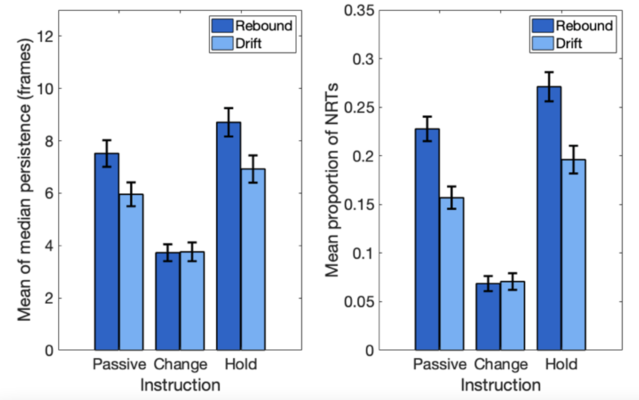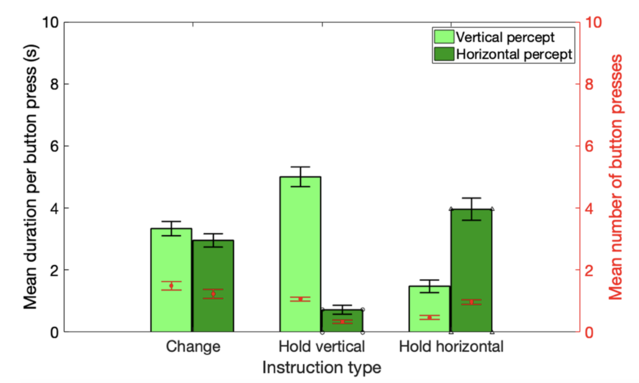Environment
Can We Have Control Over What We Perceive?
New research shows how observers can mentally control a new polystable illusion.
Posted June 30, 2022 Reviewed by Abigail Fagan
Key points
- Previous research has shown that simple polystable illusions like the Necker cube can be mentally controlled by the observer.
- A recently discovered polystable illusion, illusory apparent motion (IAM), has so many possible interpretations that control may be difficult.
- Two new studies show that observers can in fact mentally control their perception of IAM despite its complexities.
By Allison K. Allen
Polystable illusions have been of interest to psychologists for a long time. Polystable illusions are typically still or moving images that observers may experience as having more than one interpretation. For example, the Necker cube may be experienced as having either a bottom-front or a top-front interpretation (see Figure 1). Decades of research on polystable illusions have shown that how they are interpreted by observers can be biased by cognitive processes, such as learning, expectations, attention, and, the topic of this post, mental control in which observers can use their will to perceive a desired interpretation of the illusion (Kohler et al., 2008).

Try It Yourself
If you are able to experience both interpretations of the Necker cube above, you can test whether you can control what you see. Try to see the bottom-front view. Now try to see the top-front view. Try changing back and forth between the two. Or try seeing how long you can experience one of those interpretations before the object “flips” to the other interpretation. This type of mental control has been demonstrated across polystable illusions, although the amount of control observers have varies across observers and depends on the type of polystable illusion, as some are more easily controlled than others.
Recently a new polystable illusion called illusory apparent motion (or IAM) was discovered by Davidenko and colleagues (2017) in which polystability arises when observers are presented with a series randomly refreshing pixel textures. When observing the random pixel textures, observers can experience potentially countless motion patterns. For example, observers may perceive the pixels as moving up-down-up-down, left-right-left-right, clockwise or counterclockwise rotation, expansion and contraction, or shear motion. See what motion patterns you can experience yourself in this IAM demo.
IAM has many more possible interpretations than other polystable illusions which typically have between two and four interpretations. The additional possibilities could potentially pose a problem for mental control of IAM since there are more interpretations to interfere with the one observers are trying to perceive. Also, observers may not automatically experience an interpretation of IAM (as they do with other polystable illusions). For example, with the Necker cube observers automatically experience it as either the bottom-front or top-front interpretation. In IAM, observers may have to impose mental control in order to experience a coherent motion in the first place. Given these differences between IAM and other polystable illusions, we questioned whether observers would be able to mentally control IAM under similar experimental conditions that other polystable illusions have been tested.
New Research on Mental Control of Illusory Apparent Motion
In a new set of studies that I conducted, along with my colleagues Matthew T. Jacobs, and Nicolas Davidenko published in this month’s issue of the Journal of Vision, we explored whether it is possible for observers to mentally control IAM. The first experiment assisted observers with automatically experiencing an interpretation of IAM by presenting a series of priming frames that contained coherent motion, with a proportion of the pixels shifting in a particular direction. Observers were instructed to try to notice the motion pattern presented in the first few frames before the purely random frame starts. On some trials observers were instructed to try to change the motion pattern from the initial pattern as soon as possible. On other trials, observers were instructed to try to hold (or maintain) the initial motion pattern for as long as they could. The results of the first experiment found that observers were successful in mentally controlling their perception of IAM (see Figure 2).

To corroborate these findings, we conducted a second experiment that used a design similar to other polystable illusions. The second experiment did not assist observers in automatically experiencing an interpretation of IAM. Instead, observers were shown IAM displays that contained only random pixels. On some trials, observers were instructed to try to control the motion by changing back and forth between a vertical (up-down-up-down) and a horizontal (left-right-left-right) interpretation throughout the trial. On other trials, observers were instructed to try to hold a vertical or a horizontal motion pattern. The results from the second experiment again showed that observers were successful in mentally controlling their perception of IAM (see Figure 3). Importantly, this experiment used a similar paradigm used in previous studies examining simpler polystable illusions.

Taken together, the results from both experiments suggest that observers can mentally control their perception of IAM, even though the illusion requires observers to exert additional mental control in order to (1) experience an initial interpretation of IAM and (2) avoid the countless additional interpretations that IAM can afford. These findings further our understanding of the nature of IAM (e.g., How much is IAM like other polystable illusions?) and the nature of mental control of polystable illusions (e.g., Are there upper limits to the number of interpretations a polystable illusion can have in order for observers to control their perception?). However, many questions about the relationship between IAM and other polystable illusions still remain. For example, results from both experiments showed large individual differences (see Figure 4 below).

Future research on IAM might try to better understand whether these differences arise because observers have different report biases, have different criteria for categorizing motion, or whether there are truly perceptual or mental control differences across people.
References
Kohler, A., Haddad, L., Singer, W., & Muckli, L. (2008). Deciding what to see: The role of intention and attention in the perception of apparent motion. Vision Research, 48(8), 1096-1106, https://doi.org/10.1016/j.visres.2007.11.020.
Davidenko, N., Heller, N. H., Cheong, Y., & Smith, J. (2017). Persistent illusory apparent motion in sequences of uncorrelated random dots. Journal of Vision, 17(3):19, 1–17. https://doi.org/10.1167/17.3.19.
Allen, A. K., Jacobs, M. T. & Davidenko, N. (2022). Subjective control of polystable illusory apparent motion: Is control possible when the stimulus affords countless motion possibilities?. Journal of Vision, 22(7):5, 1-20. https://doi.org/10.1167/jov.22.7.5.


